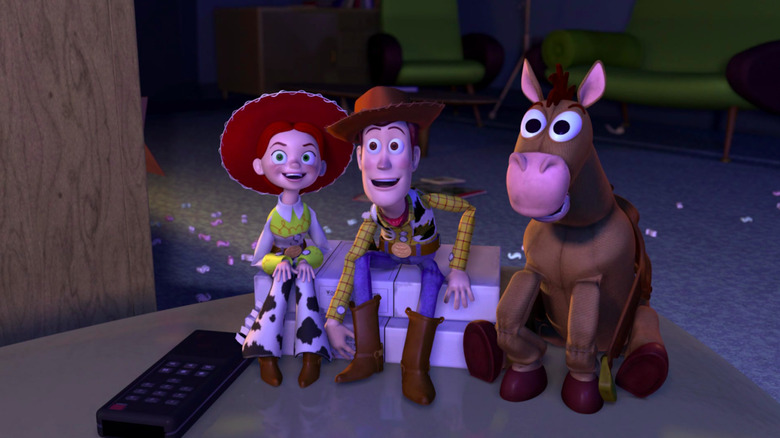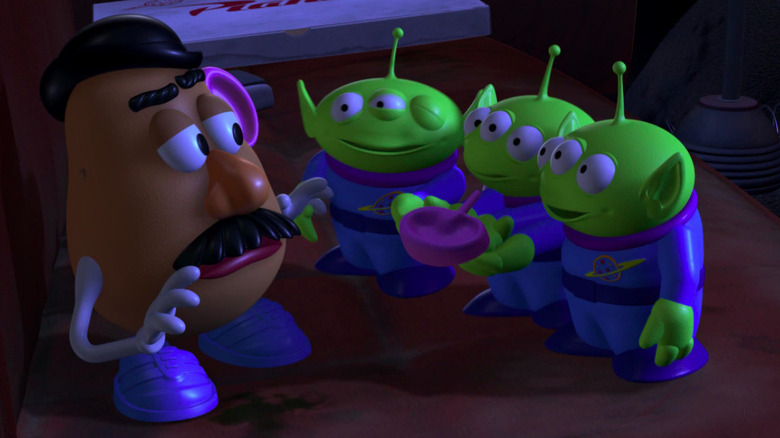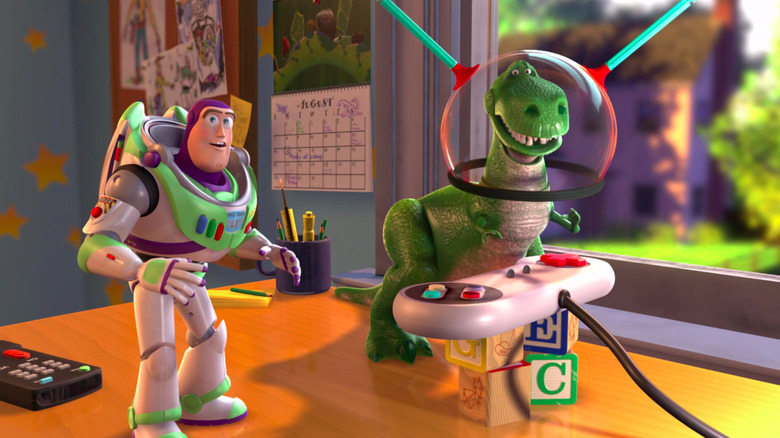Disney Didn't Originally Intend For Toy Story 2 To Hit Theaters
When I was a kid, "Toy Story" was it. Nothing compared to the fantastic adventures of Woody and his friends, and as an only child, I often spent a lot of time playing by myself, so the idea that my toys could perhaps come to life when I wasn't there was thrilling to me. I wanted nothing more than to keep the story going, and my parents generously allowed me to occasionally pick out "Toy Story" merchandise when we were out at the store. I was a major Hamm fan (still am, thank you), and I displayed my devotion to the film by asking for (and eventually getting) a Hamm stuffed animal that I was willing to protect with my life. I took that pig everywhere (I'm pretty sure I even made a nice collar for him ...), bringing the events of the film into the real world.
When the announcement for "Toy Story 2" was made, I could not have been more excited. And after seeing it for the first time, I was relieved to find that it was just as good, if not better than the original. Little did I know, though, that "Toy Story 2" was almost a direct-to-video project, which is extremely surprising given the fact that "Toy Story 2" is such a fantastic sequel. It seems bizarre to think that the "Toy Story" franchise, which has had so much success over the years, was almost relegated to the VHS bargain bins that direct-to-video movies so often find themselves in. So how exactly did one of the best sequels almost miss its chance at the theatrical release it so rightfully deserved?
There's always money in direct-to-video
When we think of DTV today, we often think of low budget, bad movies that weren't good enough to get a full theatrical treatment. But at the time "Toy Story 2" was being talked about, Disney had just had a major success with their DTV release of "The Return of Jafar," the sequel to the highly beloved and highly successful "Aladdin." "The Return of Jafar" was made for a fraction of the budget that "Aladdin" had been, and yet, it managed to make $300 million worldwide upon its release. This extreme success of a DTV film made Disney think they could easily make a lot of money making sequels to popular franchises without costing them nearly as much to make them as a theatrical feature film would. They were also, arguably a little nervous to release another sequel in theaters since "The Rescuers Down Under" — Disney's last theatrically released sequel at the time — did terribly at the box office.
With the success of "Toy Story," Pixar was hoping to piggyback off the film's phenomenal success in order to create a sequel. This idea was met with great enthusiasm from the head of Disney, but because of the success of "The Return of Jafar," there was one caveat. They wanted "Toy Story 2" to be a direct-to-video film, as well. Yes. The dreaded DTV release.
The only problem was that Pixar, a company that saw itself as a brand new pioneer in computer animation, was hesitant to create a product that was of lesser quality on a lesser budget. They rejected Disney's suggestion to allow the film to be made by Disney instead, and they set about trying to figure out how to make "Toy Story 2" for DTV release and still keep their reputation for making quality films in tact.
The little animation studio that could
At the time "Toy Story 2" was being talked about, Pixar was also working on what would eventually become "A Bug's Life" (Love you, Flik!). This meant that they did not have enough staff to devote to both projects. A JoBlo's Original "WTF Happened to this Movie?" video explains how Pixar created a separate team of animators for "Toy Story 2," and this team went on to create impressive enough initial footage that Disney agreed to change the DTV release to a full on theatrical feature. This was good news for Pixar who did not want to have to create a poorer quality film, but when John Lasseter, Chief Creative Officer at Pixar, finally looked at what the team had done, he was less than impressed. He demanded that they ask for more time in order to fix it, but Disney rejected their request.
What followed was a serious shift of directors and writers which caused a complete overhaul of the initial script. The studio scrambled to make the movie that they believed they could make, and JoBlo's Original explains how the "Toy Story 2" staff had to work incredibly hard (essentially round the clock) to get the movie finished.
Pixar finally managed to complete the film on time, and what resulted was a sequel that was, to many fans and critics, even better than the original. Even though the making of the film was painstakingly stressful, the payoff was phenomenal. Along with the success of "A Bug's Life," Pixar had cemented itself as a true giant in the world of animation, and we have to be grateful to them for refusing to let "Toy Story 2" go directly to the bottom of the DTV bargain bin found in big box stores everywhere.


